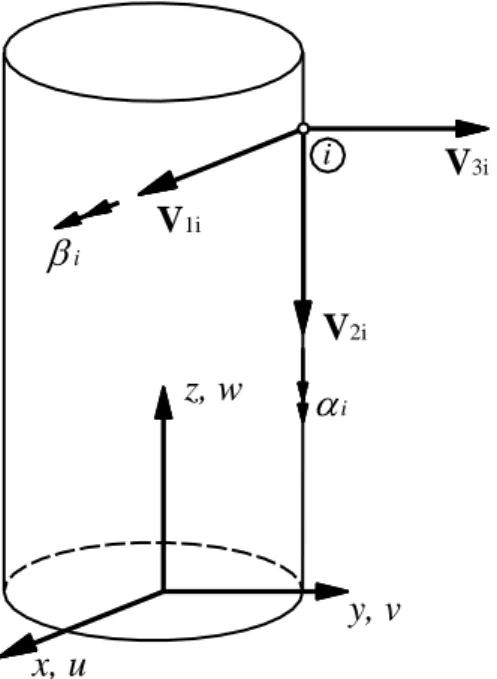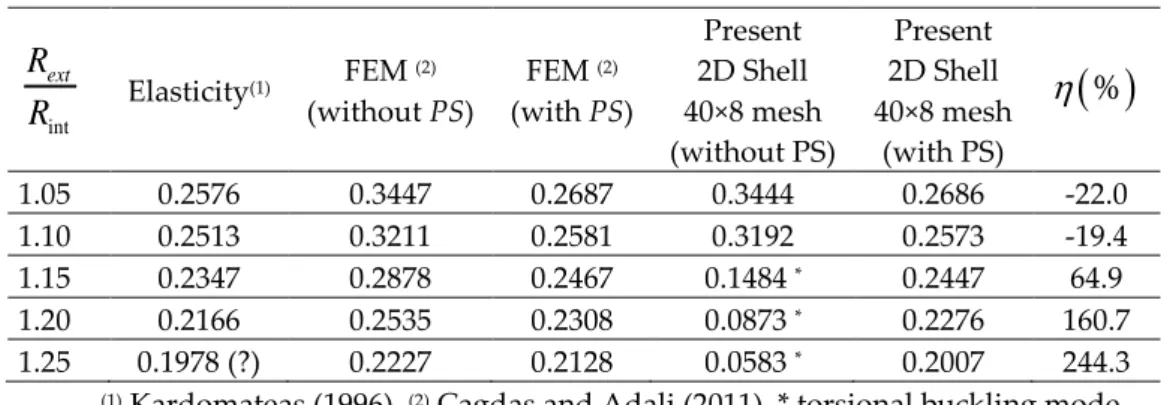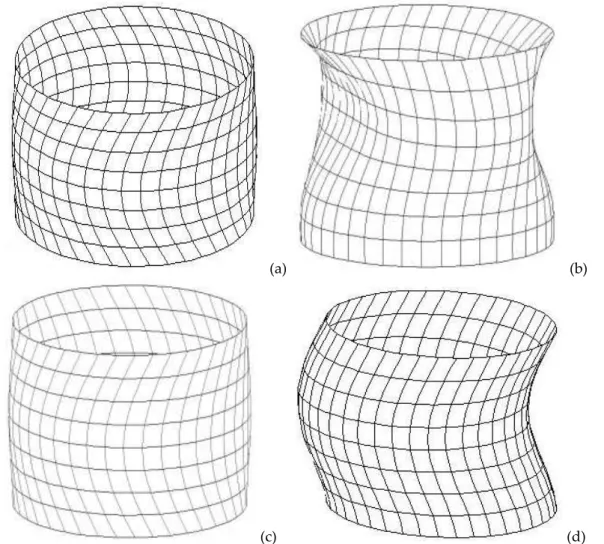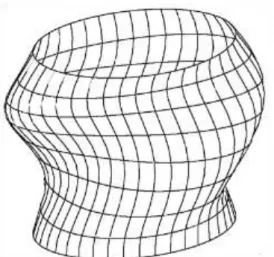THE INFLUENCE OF PRESSURE STIFFNESS ON THE TORSIONAL BUCKLING OF LAMINATED COMPOSITE CYLINDERS UNDER EXTERNAL HYDROSTATIC PRESSURE
Izzet U. CAGDAS
Akdeniz University, Engineering Faculty, Civil Engineering Department, Antalya, TURKEY izzetufuk@akdeniz.edu.tr
(Geliş/Received: 14.08.2019; Kabul/Accepted in Revised Form: 27.11.2019)
ABSTRACT: In this study, the influence of pressure stiffness on the torsional buckling of thin and moderately thick laminated composite perfect cylinders under external hydrostatic pressure is investigated. A degenerated-curved shell element is used to obtain the numerical results. First, a verification problem is solved and the element is validated for stability analysis including pressure stiffness. Then, cross-ply and angle-ply laminated composite cylinders are examined for selected length-radius ratios and stacking sequences. The results obtained show that, pressure stiffness may have a stabilizing effect against torsional buckling especially for thick orthotropic cylinders.
Keywords: Pressure stiffness, torsional buckling, composite cylinder, hydrostatic pressure
Basınç Rijitliğinin Hidrostatik Basınç Etkisi Altındaki Katmanlı Kompozit Silindirlerin Burulmalı Burkulmalarına Etkisi
ÖZ: Bu çalışmada hidrostatik basınç altındaki ince ve orta kalınlıkta katmanlı kompozit kusursuz silindirlerin burkulmasında basınç rijitliğinin etkisi araştırılmıştır. Sayısal neticeler dejenere-eğri bir kabuk elemanı kullanılarak elde edilmiştir. Öncelikle bir doğrulama problem çözülmüş ve eleman basınç rijitliğini içeren stabilite tahkiki için doğrulanmıştır. Daha sonra, dik-açılı ve eğik-açılı katmanlı kompozit silindirler seçilen uzunluk/çap değerleri ve katman düzenleri için incelenmiştir. Elde edilen neticeler basınç rijitliğinin özellikle kalın otrotropik silindirlerde burulmalı burkulmayı engellediğini göstermektedir.
Anahtar kelimeler: Basınç rijitliği, burulmalı burkulma, kompozit silindir, hidrostatik basınç
INTRODUCTION
In this study, the influence of pressure stiffness (PS) on the torsional buckling of thin and moderately thick laminated composite perfect cylinders under external hydrostatic pressure is investigated.
One of the most comprehensive studies on buckling of composite shells was performed by Seide et al.(1968) who has prepared the NASA-SP8007 monograph. Nemeth and Starnes (1998) has improved this monograph by considering imperfections. However, the literature on the influence of PS on shell stability is not extensive. PSis known to have a detrimental effect on the stability of shells under compressive loads and the related functional was derived by Koiter (1967). Schokker et al. (1996), Sridharan and Kasagi (1997) and Kardomateas (1996, 2000) have also considered the influence of PS on buckling of composite cylinders. In more recent studies, Cagdas and Adali (2011) have shown that due to pressure stiffness, a reduction of up to 30% in buckling pressure is possible for cross-ply laminated cylinders under hydrostatic pressure. The influence of PS has recently been considered for filament wound cones by Cagdas (2017), for cylindrical panels by Smitha and Nandakumar (2018), for thick
laminated composite shells by Khayat et al. (2016), and for functionally graded shells under external pressure by Khayat et al. (2017). In a more recent study, Basaglia et al. (2019) have considered PS for pipes under hydrostatic pressure and have stated that the buckling pressure will be overestimated if PS is not taken into account.
As shell thickness increases, the flexural stiffness terms increase much more rapidly than the shear stiffness terms. Thus, for thicker cylinders, torsional buckling may become more critical than flexural buckling. However, it will be shown in this study that this may not be the case taken into account.
A degenerated composite shell element based on the shell element developed by Kant (1992) is used to conduct the related structural analyses. This same element was used by Cagdas and Adali (2012a, 2012b) for linearized stability analysis and design optimization of composite shell structures. This element was recently modified by Cagdas (2017) for stability analysis considering PS. Similar shell finite elements were used by Ram and Babu (2002), and Barbosa and Ferreira (2009), Bakshi and Chakravorty (2014). ANSYS shell element “Shell 99” is a similar shell element ,which can be used for stability analysis of thin-walled composite structures; see, for example Öner et al. (2007) and Shen et al. (2017).
First, the shell element used is validated by comparing the results obtained here with the analytical results presented by Kardomateas (1996) and with the numerical results presented by Cagdas and Adali (2012) for an orthotropic composite cylinder problem. Then, numerical results are presented for cross-ply and angle-cross-ply laminated composite cylinders. The results obtained in the present study show that PS considerably interferes with the buckling behavior of relatively thick laminated composite cylinders. RESEARCH SIGNIFICANCE
The results presented in this study will provide further insight into the issue of laminated composite cylinder buckling under hydrostatic pressure. It is aimed to show that the inclusion of pressure stiffness eliminates the torsional buckling mode and increases the buckling parameter for cross-ply laminated/orthotropic composite perfect cylinders under hydrostatic pressure. This finding is of practical importance as construction of orthotropic cylinders may be advantageous or more economical. PROBLEM DEFINITION
Figure 1. The global, and nodal coordinate systems
x, u
z, w
y, v
V
1iV
3i
i
iV
2i iThe shell element is based on the following displacement field; 3 1 1
1
( , )
2
nn nn i i i i i midx
x
y
y
S
S
z
z
V
(1)where, nn,Si
,
, V3i denote the total number of nodes, the value of the ith shape function at
,
,and the unit surface normal vector at node i. respectively. The range of
and
are -1 to 1 and the range of
is t 2 tot
2
, where t denotes thickness.
i, and
i denote the rotations about V2i, and V1ias shown in Fig. 1. For the problem under consideration,
V
3i is selected as the outward unit normal andthe unit vector V1i is calculated by multiplying
V
3i with the unit vector in z direction, e3; i.e. 1i
3i
3V
V
e
as shown in Fig. 1. The details of formulation will not be given here as related information can be found elsewhere; for example see Reddy (2003). Note that, the lamination angle is taken as the angle between the fiber direction andV
1i.NUMERICAL RESULTS
First a verification problem is solved and then numerical results are presented for cross-ply and angle-ply laminated cylinders.
Verification Problem
Circumferentially reinforced graphite/epoxy cylinders of length
L
, external radius 1 m., constant thickness H, and length to external radius ratioL R
ext
10
under external pressure are analyzed here using the 2D shell element modified for the PS effect. At the ends of the shells, only radial and circumferential displacements are set equal to zero. Comparisons are made with the analytical results for orthotropic cylinders under external pressure, obtained by Cagdas and Adali (2011) and Kardomateas (1996) who have considered the effect of non-conservative loading.The material properties are given below; 1
140
E
GPa,E
2
9.1
,E
3
9.9
GPa,G
12
4.3
GPa,G
13
4.7
GPa,G
23
5.9
GPa,
12
0
.
3
, 130.02
,
23
0.49
.The results obtained for
L R
ext
10
and forR
extR
int ratios between 1.05 and 1.25 are presented inTable 1 in comparison with the results obtained by Kardomateas (1996) and Cagdas and Adali (2011), where n=2 for all cases. In Table 1,
q
cr,R
int andR
ext denote external pressure, internal radius, andexternal radius of the cylinder, respectively. The pressure acts at the outer surface, so the axial compressive force acting on top of the cylinder is calculated as f q
RintH
2.The non-dimensionalbuckling parameter is defined as; 3 3 1 cr ext cr
q R
q
E H
. (2)The percentage change in buckling pressure
%
is defined as;
,%
cr PS cr100
cr
(3)Table 1.
q
cr for orthotropic cylinders withL R
ext
10
. int extR
R
Elasticity(1) FEM (2) (without PS) FEM (2) (with PS) Present 2D Shell 40×8 mesh (without PS) Present 2D Shell 40×8 mesh (with PS)
%
1.05 0.2576 0.3447 0.2687 0.3444 0.2686 -22.0 1.10 0.2513 0.3211 0.2581 0.3192 0.2573 -19.4 1.15 0.2347 0.2878 0.2467 0.1484 * 0.2447 64.9 1.20 0.2166 0.2535 0.2308 0.0873 * 0.2276 160.7 1.25 0.1978 (?) 0.2227 0.2128 0.0583 * 0.2007 244.3 (1) Kardomateas (1996), (2) Cagdas and Adali (2011), * torsional buckling modeAs can be observed from Table 1, the results obtained using the 2D shell model are in good agreement with the elasticity solution presented by Kardomateas (1996) and in excellent agreement with the results obtained using the axisymmetric shell model with and without the inclusion of the PS effect for
R
extR
int
1.10
. However, when PS was not taken into account, a torsional buckling mode wasobserved for the case
R
extR
int
1.15. This torsional buckling mode shape, captured by the 2D shellmodel only, is shown in Fig. 2(a). However, with the inclusion of PS, the buckling mode shape changes as shown in Fig. 2(b) and the buckling parameter increases and gets closer to the one calculated using the axisymmetric model. Similarly, it can be seen from Figures 2(c) and 2(d) that, for
R
extR
int , torsionalbuckling does not occur when PS is taken into account. Also, as can be seen from Table 1, when PS is taken into account, the torsional buckling mode shape vanishes and this implies that PS, which is expected to be detrimental, unexpectedly stabilizes the cylinders with
R
extR
int
1.15 against torsionalbuckling. In Table 1, the variable h values are also presented as 64.9%, 160.7%, and 244.3% for
R
extR
int=1.15, 1.20, and 1.25 respectively.
Next, the problem is solved again for the fully clamped boundary conditions, except for the axial displacement at one of the ends, but the buckling parameters did not significantly change and therefore the results obtained are not presented here. It therefore may be stated that the influence of PS is not related with the rotational boundary conditions.
It should also be stated that, even though the formulation of the 2D degenerated shell element employed here is not based on a specific shell theory and is not as sophisticated as the shell theory based axisymmetric shell element of Cagdas and Adali (2011), where the thickness/radius ratio is also taken into account, the results obtained using the 2D shell element, presented in Table 1, are found out to be more accurate for some cases as complicated buckling mode shapes can be better captured by the 2D shell model comparing with the axisymmetric model.
Cross-ply Laminated Cylinders
Numerical results obtained for graphite-epoxy cylinders with S3 B.C., stacking sequence [90°/0°]s, and varying
R
extR
int ratios are presented forL R
ext
5, and 10 in Tables 2 and 3, respectively. It can beobserved from Table 2 that, the stabilizing influence of PS is minimal for
L R
ext
5 as flexural bucklingoccurs for the
R
extR
int ratios considered. However, as can be observed from Table 3, the influence of PSis much higher for
L R
ext
10 due to the fact that a greater surface area is under hydrostatic pressurecomparing with the case
L R
ext
5. This behavior was also observed by Cagdas and Adali (2011).It canthe case for the verification problem solved. The buckling mode shapes for
R
extR
int =1.25 with andwithout PS effect are given in Figures 3(a) and 3(b), which clearly show that the inclusion of PS in stability analysis yields a flexural buckling mode shape instead of a torsional one.
(a) (b)
(c) (d)
Figure 2. Buckling mode shapes for cross-ply laminated cylinders under hydrostatic pressure with
10
ext
L R
(a)R
extR
int =1.15, without PS (b)R
extR
int =1.15, with PS (c)R
extR
int =1.3, without PS (d) ext intR
R
=1.3, with PSTable 2.
q
cr for [90°/0°]scross-ply laminated cylinders withL R
ext
5
.int
R
R
ext 2D Shell Present 40×8 mesh (without PS) Present 2D Shell 40×8 mesh (with PS)
%
1.05 0.6503 0.51410 -20.9 1.10 0.3711 0.29810 -19.7 1.15 0.3067 0.25120 -18.1 1.20 0.2714 0.22704 -16.3 1.25 0.20677 0.20868* 0.9 * torsional buckling modeTable 3.
q
cr for [90°/0°]s cross-ply laminated cylinders withL R
ext
10
. int extR
R
Present 2D Shell 40×8 mesh (without PS) Present 2D Shell 40×8 mesh (with PS)
%
1.05 0.3601 0.2774 -23,0 1.10 0.3075 0.2712 -11,8 1.15 0.1483 0.2286 54,1 1.20 0.0872 0.21650 148,3 1.25 0.0583 0.2037 249,4* torsional buckling mode
(a) (b)
Figure 3. Buckling mode shapes for cross-ply laminated cylinders under hydrostatic pressure with
10
ext
L R
, andR
extR
int =1.25 (a), without PS (b) with PSAngle-ply Laminated Cylinders
Finally, numerical results are presented in Table 4 for angle-ply graphite-epoxy cylinders with S3 B.C., stacking sequence [55°/-55°]s,
L R
ext
10
, and varyingR
extR
int ratios. The lamination angle is selected as equal to 55° as this angle maximizes the static strength; see Messager et al. (2002).Table 4.
q
cr for [55°/-55°]s angle-ply laminated cylinders under hydrostatic pressure,L R
ext
10
.int
R
R
ext 2D Shell Present 40×8 mesh (without PS) Present 2D Shell 40×8 mesh (with PS)
%
1.05 0.1888 0.1459 -22.7 1.10 0.1617 0.1276 -21.1 1.15 0.1418 0.1142 -19.5 1.20 0.1301 0.1065 -18.1 1.25 0.1216 0.1011 -16.9It can be observed from Table 4, that PS has no positive influence for all of the
R
extR
int valuesmode shape for
R
extR
int =1.25 shown in Figure 4 is almost the same for both cases, which indicates thatfor the angle-ply cylinders considered, the buckling mode did not change with the inclusion of PS.
Figure 4. Buckling mode shape for angle-ply laminated cylinders under hydrostatic pressure with
10
ext
L R
, andR
extR
int =1.25, with and without PSCONCLUSIONS
In this study, the influence of pressure stiffness (PS) on torsional buckling of thin and moderately thick laminated composite perfect cylinders under external hydrostatic pressure is investigated using a degenerated shell finite element.
First, verification problems are solved and the super parametric shell finite element used in this study is validated for stability analysis including pressure stiffness. The results obtained for the verification problems show that the torsional buckling mode shape vanishes for orthotropic cylinders with
R
extR
int
1.15 when PS is taken into account. In order to more thoroughly investigate the problem,buckling parameters are presented for cross-ply and angle-ply laminated composite cylinders under external hydrostatic pressure and the following observations are made;
i. For cross-ply laminated cylinders, the influence of PS decreases with decreasing
L R
ext ratio and increases with increasing thickness. The positive influence of PS is higher forL R
ext
10
, and for the cross-ply cylinders considered, a nearly 250% increase in buckling pressure is observed forR
extR
int =1.25and
L R
ext
10
. However, forR
extR
int
1.1, the influence of PS is detrimental as expected.ii. For angle ply cylinders, an increase in buckling pressure due to PS is not observed as the in-plane shear stiffness values of angle-ply cylinders are higher than the ones for cross-ply cylinders. It is also shown for angle-ply cylinders that, the buckling mode shape does not change with the inclusion of PS.
In conclusion, it may be stated that for composite cylinders under external hydrostatic pressure PS should be included in the finite element model, as failure to do so may lead the designer to reach wrong estimates about both the buckling pressure, and the mode shape.
REFERENCES
Seide P, Weingarten VI, Peterson JP., 1968, “Buckling of thin-walled circular cylinders”, NASA SP-8007. Nemeth MP, Starnes Jr JH., 1998, “The NASA monographs on shell stability design recommendations: a
review and suggested improvements”, NASA-TP1998-206290, National Aeronautics and Space Administration, Langley Research Center.
Koiter, W. T. 1967, “General equations of elastic stability for thin shells”, In: Proceedings, Symposium on the Theory of Shells to Honor Lloyd Hamilton Donnett pp. 187-227.
Schokker, A., Sridharan, S., Kasagi, A., 1996, “Dynamic buckling of composite shells”, Computers & Structures, 59(1), 43-53.
Sridharan, S., Kasagi, A., 1997, “On the buckling and collapse of moderately thick composite cylinders under hydrostatic pressure”, Composites Part B, 28B, 583-596.
Kardomateas, G.A., 1996, “Benchmark three-dimensional elasticity solutions for the buckling of thick orthotropic cylindrical shells”, Composites Part B, 27B, 569-580.
Kardomateas, G.A., 2000, “Effect of normal strains in buckling of thick orthotropic shells”, Journal of Aerospace Engineering, ASCE, 13(3), 85–91.
Cagdas IU, Adali S., 2011“Buckling of cross-ply cylinders under hydrostatic pressure considering pressure stiffness”, Ocean Engineering, 38: 559-569.
Cagdas, I. U. 2017, “Optimal design of variable stiffness laminated composite truncated cones under lateral external pressure”, Ocean Engineering, 145, 268-276.
Smitha, K. K., Nandakumar, C. G., 2018,“Assessment of Collapse Pressure of Laminated Composite Subsea Shells Subjected to Hydrostatic Follower Force”, Journal of The Institution of Engineers (India): Series A, 99(4), 617-626.
Khayat, M., Poorveis, D., Moradi, S., Hemmati, M., 2016,“Buckling of thick deep laminated composite shell”, Structural Engineering and Mechanics, 58(1), 59-91.
Khayat, M., Poorveis, D., Moradi, S., 2017, “Semi-Analytical Approach in Buckling Analysis of Functionally Graded Shells of Revolution Subjected to Displacement Dependent Pressure”, Journal of Pressure Vessel Technology, 139(6), 061202.
Basaglia, C., Camotim, D., & Silvestre, N., 2019, “GBT-based buckling analysis of steel cylindrical shells under combinations of compression and external pressure”, Thin-Walled Structures, 144, 106274. Kant, T., 1992, “A general fibre-reinforced composite shell element based on a refined shear deformation
theory”, Computers & Structures, 42(3), 381-388.
Cagdas, I. U., Adali, S., 2012a, “Effect of Fiber Orientation on Buckling and First-Ply Failures of Cylindrical Shear-Deformable Laminates”, Journal of Engineering Mechanics, 139(8), 967-978. Cagdas, I., Adali, S., 2012b, “Design of a laminated composite variable curvature panel under uniaxial
compression”, Engineering Computations: International Journal for Computer-Aided Engineering and Software, 29(1), 48-64.
Ram, K. S., Babu, T. S., 2002,“Buckling of laminated composite shells under transverse load”, Composite Structures, 55(2), 157-168.
Barbosa, J. A. T., Ferreira, A. J. M., 2009“Geometrically nonlinear analysis of functionally graded plates and shells”, Mechanics of Advanced Materials and Structures, 17(1), 40-48.
Bakshi, K., Chakravorty, D., 2014,“Geometrically linear and nonlinear first-ply failure loads of composite cylindrical shells”, Journal of Engineering Mechanics, 140(12), 04014094.
Öner, G. A., Temiz, Ş., Akbulut, H., Özel, A. 2007, “İnce cidarlı, çapraz takviyeli, tabakalı kompozit tüplerde sonlu elemanlar yöntemi ile burulmalı burkulma analizi”, Dokuz Eylül Üniversitesi Mühendislik Fakültesi Fen ve Mühendislik Dergisi, 9(1), 35-44.
Shen, K. C., Pan, G., Lu J., 2017, “Buckling and layer failure of composite laminated cylinders subjected to hydrostatic pressure”, Science and Engineering of Composite Materials , 24(3), 415-422.
Reddy, J. N., 2003,Mechanics of laminated composite plates and shells: theory and analysis. CRC press.
Messager, T., Pyrz, M., Gineste, B., Chauchot, P., 2002, “Optimal laminations of thin underwater composite cylindrical vessels”, Composite Structures, 58(4), 529-537.




